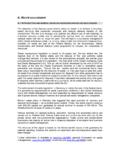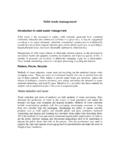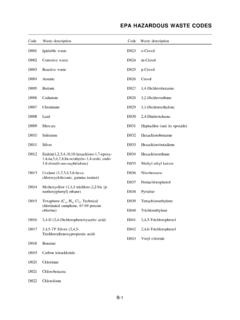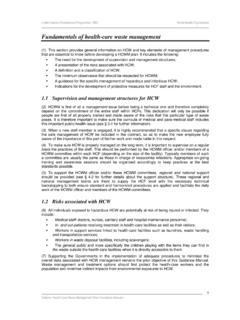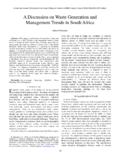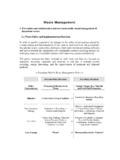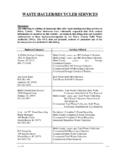Transcription of Dairy Waste Anaerobic Digestion Handbook
1 Dairy Waste Anaerobic Digestion Handbook Options for Recovering Beneficial Products From Dairy Manure Dennis A. Burke June 2001. Environmental Energy Company 6007 Hill Street Olympia, WA 98516. Environmental Energy Company 1. 360-923-2000. Table Of Contents Anaerobic Digestion Dairy Waste Handbook .. 1. 1. Dairy 3. Housing System .. 3. Free Stall 3. 4. Milk Barn .. 4. Open Lot .. 5. Transport System .. 5. Flush Systems .. 6. Scrape Systems .. 6. Front end 6. Vacuum 7. Bedding .. 7. Manure 8. Holding Tanks and Chopper Pumps .. 8. Primary Screens .. 9. Gravity Separators .. 10. Primary Holding 13. Secondary Holding 14. Summary .. 14. Anaerobic Digestion .. 16. Bacterial 16. Factors Controlling the Conversion of Waste to Gas .. 17. Waste 17. Dilution of 18. Foreign Materials .. 19. Toxic Materials .. 20. 20. Temperature .. 20. Environmental Energy Company i 360-923-2000.
2 21. Hydraulic Retention Time (HRT).. 21. Solids Retention Time (SRT).. 21. Digester Loading (kg / m3 / d).. 23. Food to Microorganism 23. End Product Removal .. 24. Digester Types .. 24. Processes that are not Appropriate for Digesting Dairy 25. Processes that can be used for Digesting Dairy 27. Anaerobic Lagoons (Very Low Rate).. 27. Completely Mixed Digesters (Low Rate) .. 28. Plug Flow Digesters (Low Rate).. 30. Contact Digesters (High Rate) .. 31. Sequencing Batch Reactors (High Rate).. 32. Contact Stabilization Reactors (High Rate).. 32. Phased Digesters .. 33. Hybrid 35. Qualitative Analysis of Anaerobic Processes .. 35. Solids Concentration Limitations .. 35. Digestion of the Entire Waste 35. Foreign Material Processing .. 36. Odor Control .. 36. Stability, Flexibility, and 36. Nutrient Concentration and Retention .. 37. Additional Substrate Processing.
3 37. Energy Production .. 38. Conventional 38. 40. High Rate Anaerobic 40. Cost of Anaerobic Processes for Dairy 42. Alternative Waste Management Systems .. 44. Existing Manure 44. Housing .. 45. 45. Treatment .. 47. 48. Final Disposal .. 49. Evaluation .. 49. 51. Environmental Energy Company ii 360-923-2000. Dairy Waste Anaerobic Digestion Handbook Dennis A. Burke Introduction The rapid growth in the size of Dairy operations has resulted in new laws and regulations governing the handling and disposal of manure (Mitchell and Beddoes 2000). Requirements for nutrient management plans, manure solids disposal, and odor control (HouseBill 2001) make it necessary that new manure management approaches be considered. One of the more promising methods is Anaerobic Digestion . Anaerobic Digestion is a natural process that converts biomass to energy.
4 Biomass is any organic material that comes from plants, animals or their wastes. Anaerobic Digestion has been used for over 100 years to stabilize municipal sewage and a wide variety of industrial wastes. Most municipal wastewater treatment plants use Anaerobic Digestion to convert Waste solids to gas. The Anaerobic process removes a vast majority of the odorous compounds (Lusk 1995),(Wilkie 2000),(Wilkie 2000). It also significantly reduces the pathogens present in the slurry (Lusk 1995). Over the past 25 years, Anaerobic Digestion processes have been developed and applied to a wide array of industrial and agricultural wastes (Speece 1996), (Ghosh 1997). It is the preferred Waste treatment process since it produces, rather than consumes, energy and can be carried out in relatively small, enclosed tanks. The products of Anaerobic Digestion have value and can be sold to offset treatment costs (Roos 1991).
5 Anaerobic Digestion provides a variety of benefits. The environmental benefits include: Odors are significantly reduced or eliminated. Flies are substantially reduced. A relatively clean liquid for flushing and irrigation can be produced. Pathogens are substantially reduced in the liquid and solid products. Environmental Energy Company 1. 360-923-2000. Greenhouse gas emissions are reduced. And finally, nonpoint source pollution is substantially reduced. On the economic side, additional benefits are provided. The time devoted to moving, handling, and processing manure is minimized. Biogas is produced for heat or electrical power. Waste heat can be used to meet the heating and cooling requirements of the Dairy . Concentrating nutrients to a relatively small volume for export from the site can reduce the land required for liquid Waste application.
6 The rich fertilizer can be produced for sale to the public, nurseries, or other crop producers. Income can be obtained from the processing of imported wastes (tipping fees), the sale of organic nutrients, greenhouse gas credits, and the sale of power. Power tax credits may be available for each kWh of power produced. Greenhouse tax credits may become available for each ton of carbon recycled. Finally the power generated is distributed power which minimizes the need to modify the power grid. The impact of new power on the power grid is minimized. In order to achieve the benefits of Anaerobic Digestion , the treatment facility must be integrated into the Dairy operation. Unfortunately, no single Dairy can serve as a model for a manure treatment facility. The operation of the Dairy will establish the digester loading and the energy generated from the system.
7 The Anaerobic facility must be designed to meet the individual characteristics of each Dairy . This manual provides an introduction to the Anaerobic Digestion of Dairy manure. It is divided into three parts. The first describes the operation and Waste management practices of Idaho dairies. The second introduces Anaerobic Digestion and the Anaerobic Digestion processes suitable for Dairy Waste . The third presents typical design applications for different types of dairies and establishes the cost and benefits of the facilities. Environmental Energy Company 2. 360-923-2000. Dairy Operations Dairy operations significantly affect the quantity and quality of manure that may be delivered to the Anaerobic Digestion system. In addition to the number of milk and dry cows, the housing, transport, manure separation, and bedding systems used by the Dairy establishes the amount of material that must be handled and the amount of energy produced.
8 Housing System Confined Dairy animals may be housed in a variety of systems. Commonly used housing systems include free stalls, corrals with paved feed lanes, and open lot systems. Milk cows, dry cows and heifers may be housed in free stalls, corrals, and open-lots on the same Dairy . The type of housing used determines the quantity of manure that can be economically collected. Free Stall Barns Free stalls are currently the most popular method for housing large Dairy herds. Free stall housing provides a means for collecting essentially all of the manure. Typical Free Stall Barn with Center Feed Lane Environmental Energy Company 3. 360-923-2000. Corrals Corral systems with paved feed lanes are also commonly used. The manure deposited in the feed lanes can be scraped or flushed daily. From 40 to 55- percent of the excreted manure may be deposited and collected from the corral feed lane.
9 The balance of the manure may be deposited in the milk barn (10 to 15 percent) or the open lot (30 to 50%). Typically the manure deposited in the open lot is removed two to three times a year. It may have little net energy value after being stored in the open lot over prolonged periods of time. For corral systems one must make a reasonable determination of the recoverable manure deposited in the feed lane, corral, and milk barn. Corral with Paved Feed Lane for Scrape or Vacuum Collection Corral systems also use a considerable amount of bedding material during the winter months. The straw bedding is generally removed in the spring and placed on the fields prior to spring planting. Milk Barn Dairy cows are milked two to three times a day. The cows are moved from their stalls to the milk parlor holding area. The milk parlor and holding area are normally flushed with fresh water.
10 From 10 to 15 percent of the manure is deposited in the milk parlor. In addition to the manure that is flushed, the cows may be washed with a sprinkler system. Warm water that is produced by the refrigeration compressors, vacuum pumps, and milk cooling system may be used Environmental Energy Company 4. 360-923-2000. for drinking water, manure flushing or washing the cows. It has been estimated that 5 to 150 gallons of fresh water per milk cow is used in the milking center. More common values are 10 to 30 gallons of fresh water per milk cow. The quantity and quality of water discharge from the milk parlor must be accurately measured. In many cases, the Waste deposited in the milk barn is processed in a separate Waste management system. Open Lot In open lot systems the manure is deposited on the ground and scraped into piles. The manure is removed infrequently (once or twice a year).
